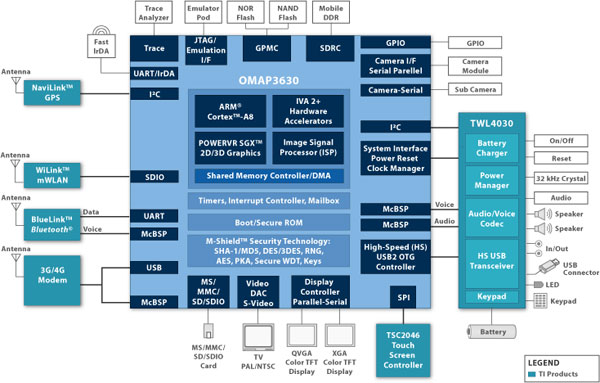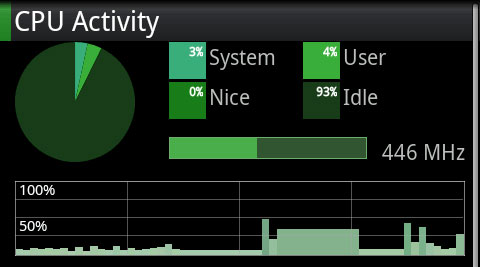Motorola Droid X: Thoroughly Reviewed
by Brian Klug on July 20, 2010 4:27 PM EST- Posted in
- Smartphones
- Motorola Droid X
- OMAP
- Mobile
Years ago, before we hit the power wall, CPU innovation happened at a slow but steady pace. Every five years or so we’d get a new microprocessor architecture and every couple of years we’d get smaller transistors.
The smaller transistors made chips run cooler and at higher clock speeds. The shrink in die area also paved the way for new features, but between major architectural shifts those features normally came in the form of larger caches.
Texas Instruments’ move from the OMAP 3430, used in phones like the Palm Pre, to the OMAP 3630 used in the Droid X is reminiscent of this sort of steady progress I mentioned above.
The OMAP 3430 was built on a 65nm process (like Qualcomm's Snapdragon), while the 3630 is a 45nm shrink (like Apple's A4). Architecturally the two SoCs are very similar. They both use a standard ARM Cortex A8 CPU paired with an Imagination Technologies PowerVR SGX 530 GPU. The two SoCs fit in the same size package (12mm x 12mm BGA) and are ball compatible. If a customer wanted to, it could simply drop in a 3630 into an existing 3430 design with minimal engineering efforts.
Note that the most direct competitor to the 3630 is Qualcomm’s Snapdragon. While TI uses a standard Cortex A8 core from ARM, Qualcomm designed its own low power ARMv7 based core that is similar, but not identical to the Cortex A8. Both are dual-issue, in-order architectures - they’re like the original Pentium, but in your phone. Qualcomm also integrated the cellular modem into the Snapdragon SoC while TI’s OMAP 3 is a strict application processor - the modem is housed in a separate chip.

On the CPU side TI doubled the L1 cache of the 3430 to 64KB (32KB instruction, 32KB data). The L2 cache remains unchanged at 256KB. We won’t get a larger L2 until the OMAP 4, which will ship with a 1MB L2 shared among its two cores. There are the usual tweaks and bug fixes which may improve performance per clock a little bit over the 3430, but overall the 3630 just gets a larger L1 as a result of the die shrink - oh and a much higher clock speed.
The Cortex A8 now runs at up to 1GHz. The OMAP 3430 topped out at 800MHz in shipping configurations but most vendors ran it at sub-600MHz speeds to save power. The 3630 in the Droid X runs at a full 1GHz. It's worth pointing out that Qualcomm was able to hit 1GHz on a similar architecture at 65nm by designing its core from the ground up. There's clearly value in these custom designs from a performance and time to market standpoint. These advantages will only become more critical as the SoC performance wars heat up.
Power Consumption
The OMAP 3 as well as Qualcomm’s Snapdragon SoC support dynamic voltage and frequency scaling. Based on application demand and cues from the OS the CPU clock speed and voltage can vary. The Cortex A8 in the OMAP 3630 will drop down to the low 300MHz range when idle at the Android home screen and ramp all the way up to 1GHz when needed.

TI's OMAP 3630 running at full tilt

...and automatically underclocked to 446MHz under lighter load
This is nothing unique to the OMAP 3630, but it shows that frequency and voltage scaling is alive and well in Android.
TI supports full power and clock gating. All major IP blocks are placed on their own power islands, so based on input from the OS the CPU, GPU, video decoder, etc... can ramp down depending on the application needs at the time. The power and clock gating is no more granular in the 3630 than it was in the 3430. What has changed however are operating voltages.
While the 3430 needed 1.35V to hit 720MHz, the 3630 can reach 1GHz at around 1.26V. That still sounds a bit high to me but at the same clock speed, thanks to voltage scaling, you can drop power by around 30% compared to the 3430.
Coupled with the dynamic voltage/frequency scaling of all OMAP 3 parts this means that overall power efficiency should be better on the 3630 vs. the 3430. The added CPU performance in the form of larger L1 caches and a higher clock speed should make tasks complete quicker and allow the 3630 to get to a lower voltage state than the 3430 was ever able to reach.
Samsung has already shown off 1.2GHz+ versions of its Cortex A8 based SoC at 45nm, so I would expect to see higher clocked versions of the 45nm OMAP 3 family to follow at some point in time.










89 Comments
View All Comments
jeffjcom - Wednesday, July 21, 2010 - link
Monoprice cables are Mini not Micro.MrPete123 - Wednesday, July 21, 2010 - link
A little bit off topic but....I haven't seen any mention of Android 2.2 and battery life. Do we know if executing code significantly faster allows the CPU to sleep more often, saving power? Or perhaps there's other power saving alterations in 2.2?bplewis24 - Wednesday, July 21, 2010 - link
I'm interested in this as well. Maybe update the Nexus One review with this info?Brandon
stlc8tr - Wednesday, July 21, 2010 - link
"It’s interesting that Motorola is sticking to FWVGA - this is admittedly exactly 16:9 aspect ratio"Well, I guess it depends on how digits of precision you're using. 854x480 is actually 16:8.992974. :-)
soydios - Wednesday, July 21, 2010 - link
Whichever author wrote that, you are not being too picky about the short 3-foot length of the included USB cable. 6 feet or bust. I'd say that the majority of us like to have the phone on the nightstand or desk while it's charging, not on the floor next to the power socket.Piano Man - Wednesday, July 21, 2010 - link
Now this is what I call a smartphone review. I'm glad that these smartphones are getting full review treatment like they were computer systems. Since I got my Moto Droid at work 7 months ago, I think about 25-30 more have followed suit. I really thing these phones are gonna become our primary all-in-one electronic system sooner than we think. Glad they're getting the review they deserve. Please keep it up for the future biggie's (Samsung Galaxy, and the new OMAP processors).jleach1 - Thursday, July 22, 2010 - link
"droid x lastest longest on a single charge"not sure if this was an accent -=D
dumpsterj - Thursday, July 22, 2010 - link
man i want this phone lol. I was gonna wait to see how windows phone 7 works out cuz i love zune . However it seems verizon is pissing all over microsoft lately with the kin and i wonder if vz will even get the damn phones.VashHT - Thursday, July 22, 2010 - link
Anyone else notice there evo benchmarks a lot better in this article than in the official evo review? It seems like the updates might have actually helped it out, it went from being slower to the incredible to faster in this review (in browsing tests I mean), you guys should update your evo review with the patches,i think they fixed the few little flaws the evo had when it first came out.One43637 - Thursday, July 22, 2010 - link
Great to hear Brian. I just picked up a Vibrant after owning a G1 for the duration. Phone is great, and I was pleasantly surprised how unobtrusive TouchWiz 3.0 is. Phone does not feel cheap at all, just because it has a plastic back.Can't wait to read your review and Froyo!